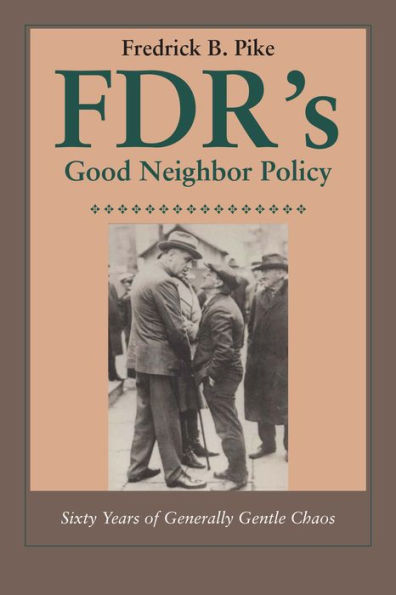FDR's Good Neighbor Policy: Sixty Years of Generally Gentle Chaos
A study of how and why US-Latin American relations changed in the 1930s: “Brilliant . . . [A] charming and perceptive work.” ―Foreign Affairs
During the 1930s, the United States began to look more favorably on its southern neighbors. Latin America offered expanded markets to an economy crippled by the Great Depression, while threats of war abroad nurtured in many Americans isolationist tendencies and a desire for improved hemispheric relations. One of these Americans was Franklin Delano Roosevelt, the primary author of America’s Good Neighbor Policy.
In this thought-provoking book, Bolton Prize winner Fredrick Pike takes a wide-ranging look at FDR’s motives for pursuing the Good Neighbor Policy, how he implemented it, and how its themes played out up to the mid-1990s. Pike’s investigation goes far beyond standard studies of foreign and economic policy. He explores how FDR’s personality and Eleanor Roosevelt’s social activism made them uniquely simpático to Latin Americans. He also demonstrates how Latin culture flowed north to influence U.S. literature, film, and opera. This book is essential reading for everyone interested in hemispheric relations.
1114370293
During the 1930s, the United States began to look more favorably on its southern neighbors. Latin America offered expanded markets to an economy crippled by the Great Depression, while threats of war abroad nurtured in many Americans isolationist tendencies and a desire for improved hemispheric relations. One of these Americans was Franklin Delano Roosevelt, the primary author of America’s Good Neighbor Policy.
In this thought-provoking book, Bolton Prize winner Fredrick Pike takes a wide-ranging look at FDR’s motives for pursuing the Good Neighbor Policy, how he implemented it, and how its themes played out up to the mid-1990s. Pike’s investigation goes far beyond standard studies of foreign and economic policy. He explores how FDR’s personality and Eleanor Roosevelt’s social activism made them uniquely simpático to Latin Americans. He also demonstrates how Latin culture flowed north to influence U.S. literature, film, and opera. This book is essential reading for everyone interested in hemispheric relations.
FDR's Good Neighbor Policy: Sixty Years of Generally Gentle Chaos
A study of how and why US-Latin American relations changed in the 1930s: “Brilliant . . . [A] charming and perceptive work.” ―Foreign Affairs
During the 1930s, the United States began to look more favorably on its southern neighbors. Latin America offered expanded markets to an economy crippled by the Great Depression, while threats of war abroad nurtured in many Americans isolationist tendencies and a desire for improved hemispheric relations. One of these Americans was Franklin Delano Roosevelt, the primary author of America’s Good Neighbor Policy.
In this thought-provoking book, Bolton Prize winner Fredrick Pike takes a wide-ranging look at FDR’s motives for pursuing the Good Neighbor Policy, how he implemented it, and how its themes played out up to the mid-1990s. Pike’s investigation goes far beyond standard studies of foreign and economic policy. He explores how FDR’s personality and Eleanor Roosevelt’s social activism made them uniquely simpático to Latin Americans. He also demonstrates how Latin culture flowed north to influence U.S. literature, film, and opera. This book is essential reading for everyone interested in hemispheric relations.
During the 1930s, the United States began to look more favorably on its southern neighbors. Latin America offered expanded markets to an economy crippled by the Great Depression, while threats of war abroad nurtured in many Americans isolationist tendencies and a desire for improved hemispheric relations. One of these Americans was Franklin Delano Roosevelt, the primary author of America’s Good Neighbor Policy.
In this thought-provoking book, Bolton Prize winner Fredrick Pike takes a wide-ranging look at FDR’s motives for pursuing the Good Neighbor Policy, how he implemented it, and how its themes played out up to the mid-1990s. Pike’s investigation goes far beyond standard studies of foreign and economic policy. He explores how FDR’s personality and Eleanor Roosevelt’s social activism made them uniquely simpático to Latin Americans. He also demonstrates how Latin culture flowed north to influence U.S. literature, film, and opera. This book is essential reading for everyone interested in hemispheric relations.
13.49
In Stock
5
1

FDR's Good Neighbor Policy: Sixty Years of Generally Gentle Chaos
422
FDR's Good Neighbor Policy: Sixty Years of Generally Gentle Chaos
422
13.49
In Stock

Product Details
| ISBN-13: | 9780292786097 |
|---|---|
| Publisher: | University of Texas Press |
| Publication date: | 02/24/2022 |
| Sold by: | Barnes & Noble |
| Format: | eBook |
| Pages: | 422 |
| File size: | 6 MB |
About the Author
From the B&N Reads Blog
